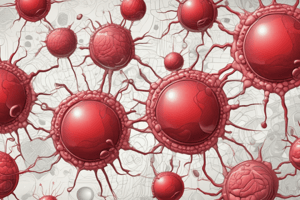Podcast
Questions and Answers
What is the primary function of red blood cells?
What is the primary function of red blood cells?
- To fight against bacterial infections
- To regulate blood clotting
- To aid in the production of immune cells
- To carry oxygen from the lungs to the body tissues (correct)
Which of the following is a characteristic of red blood cells in peripheral blood smears?
Which of the following is a characteristic of red blood cells in peripheral blood smears?
- They are 10-15 μm in diameter
- They appear as rounded, bright pink-stained cells (correct)
- They have a uniform colour distribution
- They are rectangular in shape
What is the term for a deficiency of all three cellular components of the blood?
What is the term for a deficiency of all three cellular components of the blood?
- Pancytopenia (correct)
- Anaemia
- Neutropenia
- Thrombocytopenia
What is the term for a deficiency of red blood cells?
What is the term for a deficiency of red blood cells?
What is the cause of the bright pink colour of red blood cells in peripheral blood smears?
What is the cause of the bright pink colour of red blood cells in peripheral blood smears?
What is the significance of the biconcave shape of red blood cells?
What is the significance of the biconcave shape of red blood cells?
What is the term for a deficiency of white blood cells?
What is the term for a deficiency of white blood cells?
What is the term for a deficiency of platelets?
What is the term for a deficiency of platelets?
What is the presentation of a patient with bone marrow failure?
What is the presentation of a patient with bone marrow failure?
What is the significance of the presence of hepatomegaly, splenomegaly, or lymphadenopathy in a patient with bone marrow failure?
What is the significance of the presence of hepatomegaly, splenomegaly, or lymphadenopathy in a patient with bone marrow failure?
Flashcards are hidden until you start studying
Study Notes
Blood Cells
- Blood has four major elements: red blood cells (erythrocytes), white blood cells (leukocytes), platelets (thrombocytes), and plasma.
- Red blood cells transport oxygen from the lungs to peripheral tissues.
- White blood cells have a defensive role, destroying infecting organisms and assisting in removal of dead or damaged tissues.
- Platelets are the first line of defense against damage to blood vessels, adhering to defects and participating in blood clotting.
Haemopoiesis
- Haemopoiesis is the formation of blood cellular components, derived from haematopoietic stem cells (HSCs).
- The site of blood cell formation changes during fetal development, from the yolk sac to the liver and spleen.
- Fetal haemopoiesis occurs mainly in the liver, and later in the bone marrow.
- In adult life, blood cells are made in the bone marrow.
Red Blood Cells (Erythrocytes)
- Red blood cells are highly deformable and specialized for carrying oxygen.
- They are responsible for oxygen transport and appear as rounded, bright pink-stained cells in peripheral blood smears.
- They are 6.5–8.5 μm in diameter and have a biconcave shape, which maximizes their surface area/volume ratio for oxygen exchange.
Hereditary Spherocytosis
- Hereditary spherocytosis is caused by an abnormal arrangement of the internal cytoskeleton of red cells.
- A defect in spectrin or the ankyrin binding of spectrin leads to an unbraced red cell membrane that is easily deformed.
- Red cells do not form their normal biconcave disc shape, but appear round and convex.
- They are abnormally brittle and less deformable, leading to hemolysis and excessive breakdown of red blood cells.
Blood Film
- A blood film is made by smearing a sample of peripheral blood on a slide and staining it with a mixture of dyes.
- Four white blood cells (nucleated) of various types are seen against a background of numerous smaller anucleate red blood cells.
Studying That Suits You
Use AI to generate personalized quizzes and flashcards to suit your learning preferences.



